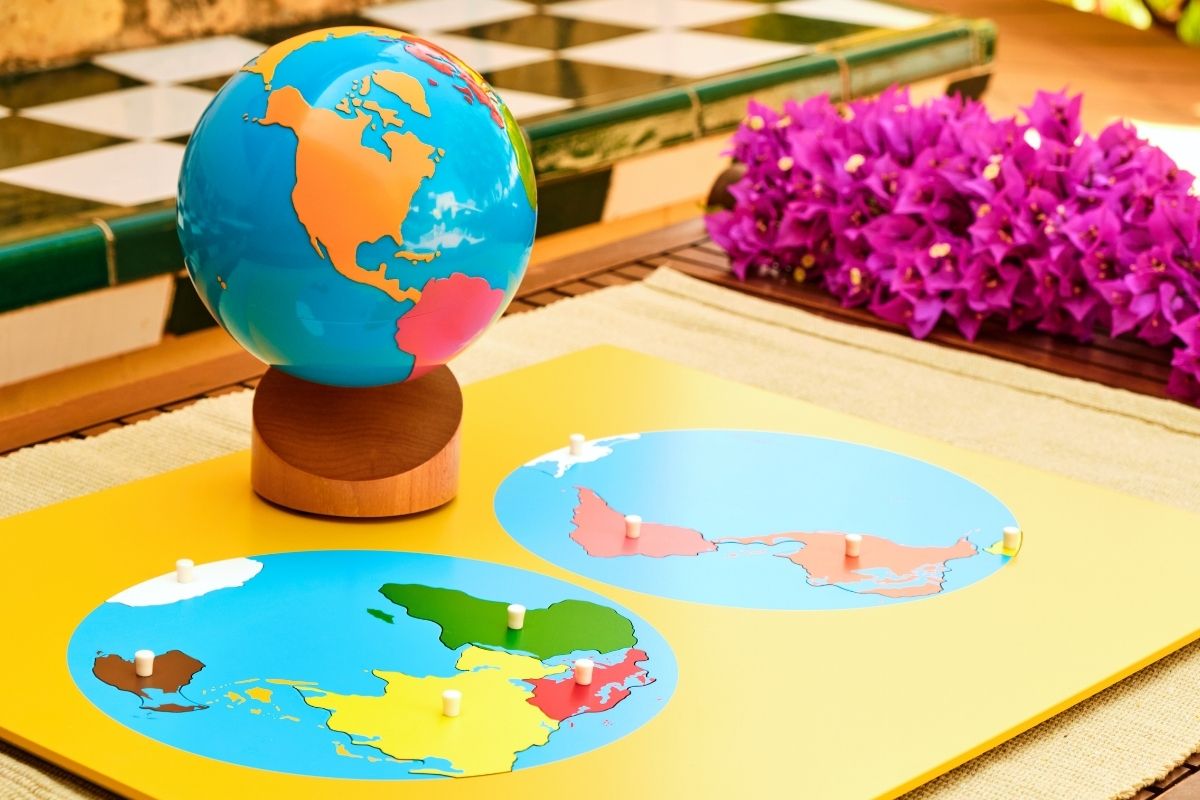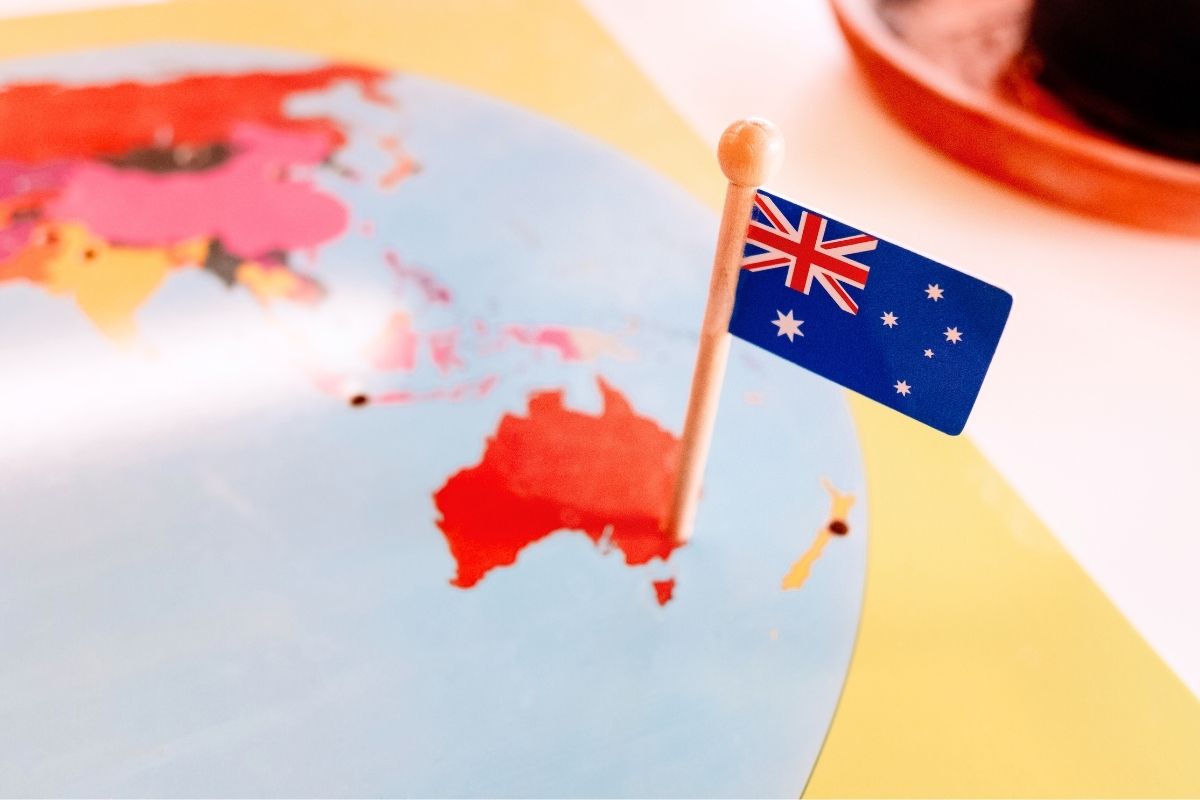Montessori geography materials facilitate learning and help children in understanding the world around them. They offer a hands-on approach, making it easier for students to learn about continents, countries, landmarks, maps, and more. This article explores various Montessori-inspired geography materials and their benefits.
The Montessori Approach to Geography
At the heart of Montessori education lies the belief in the interconnectedness of all things. This philosophy seamlessly extends to geography, where children are taught to view the world as an intricate web of physical and cultural systems. Instead of rote memorization, Montessori students are encouraged to explore, question, and understand the world around them. This ‘big picture’ perspective gradually narrows down to intricate details, ensuring a comprehensive grasp of geographical concepts.
Why Use Montessori Geography Materials?
As an educational method that emphasizes self-directed learning and a tactile experience, Montessori believes one can better comprehend any subject through direct interaction with related materials. Geography is no exception, as Montessori tools allow learners to connect with the Earth and its components physically and visually by exposing them to various geographical concepts and details.
-
Tactile Learning Experience
Montessori geography materials, such as sandpaper globes and puzzle maps, provide a tactile experience. Children can feel the contours of continents, understand the difference between land and water, and piece together the world, quite literally. This hands-on approach ensures that learning is not just a visual or auditory experience but engages multiple senses, leading to better retention and understanding.
-
Self-directed Exploration
Montessori materials are designed for self-directed learning. A child can choose a puzzle map, work with it, identify countries or regions, and move on to another material at their own pace. This fosters independence and instills a love for learning, as children are not bound by structured lessons or time constraints.
-
Holistic Understanding
Montessori geography does not limit itself to just physical geography. With materials that cover flora, fauna, cultures, and economies of various regions, children get a holistic view of the world. They learn not just about places but the people, animals, plants, and lifestyles associated with those places.
-
Integration with Other Subjects
Montessori geography materials seamlessly integrate with other subjects. For instance, while studying a continent, children might also delve into the history, art, and music of its countries. This interdisciplinary approach ensures that children see the world in its entirety, not in isolated fragments.
-
Encouraging Curiosity and Exploration
The very design of Montessori materials sparks curiosity. Children might wonder about the unique shape of a continent, the culture of a particular region, or the animals native to a country. This curiosity often leads them to explore further, ask questions, and seek answers, turning them into lifelong learners.
-
Real-world Application
Many Montessori geography activities have real-world applications. For instance, children might learn about the topography of a region and then engage in gardening activities that mirror that topography. Such activities ensure that learning is not confined to the classroom but extends to the real world.
Different Types of Montessori Geography Materials
Understanding our planet’s vastness and diversity is a foundational aspect of Montessori geography. The curriculum employs a range of materials that allow children to visualize, touch, and explore the Earth’s physical features, ensuring a comprehensive grasp of geographical concepts.
1. Globes
Montessori globes serve as a child’s first introduction to the Earth’s layout. There are two primary types: the solid-colored globe, which helps children understand the concepts of land and water, and the colored globe, which introduces them to different continents. By rotating, touching, and observing these globes, children gain a three-dimensional understanding of our planet.
There are two primary types of Montessori globes:
- Sandpaper Globe: A small globe featuring sandpaper surfaces for landmasses and smooth surfaces for water bodies, enabling even young learners to feel the difference between continents and oceans.
- Colored Globe: Focusing on introducing the concept of continents, this type of globe assigns each landmass a distinct color, facilitating easy recognition and memorization.
2. Puzzle Maps
One of the most iconic Montessori geography tools, puzzle maps provide children with a unique opportunity to explore various geographical regions. Made primarily of wood, each country or state on these maps is represented as a separate, removable piece, often color-coded for easier differentiation. Some specialized versions of these puzzle maps further delve into the states within countries, such as the United States.
3. Land & Water Forms
This Montessori material introduces students to basic land and water formations such as islands, peninsulas, bays, and more using three-dimensional models made from wood or plastic. By manipulating these miniatures, learners gain a direct sensorial experience of the different natural geographic landscapes.
4. Pin Maps
Montessori pin maps, often combined with flag sets, offer a comprehensive approach to geography. The flag set enables children to learn about flags from various countries through association and symbol identification. Each flag, mounted on a pin, corresponds to a specific nation or region on the map. As children place these pins on the map, they not only learn about the flag but also its geographical location, reinforcing their spatial understanding.
5. Continent Boxes
A cornerstone in Montessori geography, the Montessori continent boxes are filled with artifacts, pictures, and items from specific continents. These boxes offer a tactile and visual exploration of the cultures, animals, and landmarks of different regions, allowing children to immerse themselves in the diverse world beyond their immediate surroundings.
6. Geography Folders & Cards
Filled with fact cards, picture cards, description cards, or any other type of visual aid, geography folders offer organized and accessible information focused on particular topics. For example, a folder might contain details about capital cities, important rivers, or famous landmarks. Matching activities may involve combining picture cards with accompanying descriptions or objects.
7. Landmark Objects & Cards
An essential aspect of exploring the world is learning about its notable landmarks. This Montessori material includes miniature representations accompanied by picture or description cards to facilitate recognition and contextual understanding of different monuments and natural wonders worldwide.
8. Time Zones Activity
Teaching time zones is crucial for students to grasp how time varies across Earth. Through worksheets or interactive manipulatives, learners can explore the concepts of longitude, latitude, and time zones in an engaging and logical manner.
9. Maps & Atlases
Unfolding large maps and exploring the variety of information they provide helps children grasp advanced geographical knowledge. Montessori classrooms often integrate control maps or transparent overlays that highlight specific aspects like political boundaries, population, climate zones or geographical features to fuel curiosity-driven learning further. Often accompanied by cards or labels, continent maps encourage children to delve deeper, exploring each continent’s unique attributes and characteristics.
10. Geography Tools & Learning Toys
From compasses and magnifying glasses to interactive globes and puzzles, various Montessori-inspired tools and learning toys encourage playful and immersive geography education. These engaging materials allow learners to experiment, discover, and develop a strong foundation in this essential subject matter.
Montessori Geography Materials Chart
This chart provides a comprehensive overview of Montessori geography materials, detailing their descriptions, primary purposes, additional information, and the typical age range when children are introduced to these concepts.
| Material Name | Description | Purpose | Additional Information | Age of Learning |
|---|---|---|---|---|
| Globes | Spherical representations of Earth. Two types: solid-colored and colored (each continent is color-coded). | Introduce children to Earth’s layout; foster three-dimensional understanding. | Often paired with lessons about continents and oceans. | 2-4 years |
| Puzzle Maps | Wooden maps where each country or state is a separate, removable piece. Often color-coded. | Provide a detailed exploration of continents, countries, and states. Enhance spatial understanding. | Some specialized versions focus on states within countries, like the USA. | 3-6 years |
| Land & Water Form Trays | Three-dimensional models representing different land and water formations. | Introduce basic geographical formations like islands, peninsulas, bays, etc. | Often made from wood or plastic. | 3-5 years |
| Pin Maps | Maps combined with flag sets. Each flag, mounted on a pin, corresponds to a specific nation or region. | Teach children about flags and their geographical locations. Reinforce spatial understanding. | Can be used for various activities, including games and quizzes. | 4-7 years |
| Geography Folders & Cards | Folders containing fact cards, picture cards, description cards, or other visual aids focused on specific topics. | Offer organized and accessible information on topics like capital cities, rivers, landmarks, etc. | Matching activities often involve combining picture cards with descriptions or objects. | 5-8 years |
| Landmark Objects & Cards | Miniature representations of landmarks accompanied by picture or description cards. | Facilitate recognition and understanding of different monuments and natural wonders worldwide. | Can be used in conjunction with continent boxes for a more comprehensive cultural exploration. | 5-9 years |
| Time Zones Activity | Worksheets or interactive manipulatives exploring the concepts of longitude, latitude, and time zones. | Help students grasp how time varies across Earth. | Often paired with discussions about global interconnectedness. | 6-9 years |
| Maps & Atlases | Large maps, control maps, or transparent overlays highlighting specific geographical aspects. | Provide a detailed view of political boundaries, population, climate zones, and other geographical features. | Encourage curiosity-driven learning and can be paired with other materials for in-depth exploration. | 6-12 years |
| Geography Tools & Learning Toys | Tools like compasses, magnifying glasses, interactive globes, and puzzles. | Encourage playful and immersive geography education. Enhance experimentation and discovery. | These materials often bridge the gap between traditional learning and Montessori’s hands-on approach. | 4-8 years |
Montessori Geography Materials for Home Schooling
Adapting to a home schooling environment is more feasible than ever thanks to the availability of Montessori geography materials. Caregivers can choose from numerous products catering to different age groups, competencies, and interests, ensuring an enriching educational journey for every child-learner.
In essence, Montessori geography materials offer diverse and hands-on ways for children to comprehend our planet and its wonders. Honing such global awareness early on lays the groundwork for responsible stewardship of Earth, ultimately fostering appreciation and empathy across borders and cultures.





